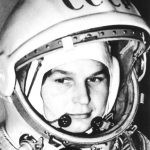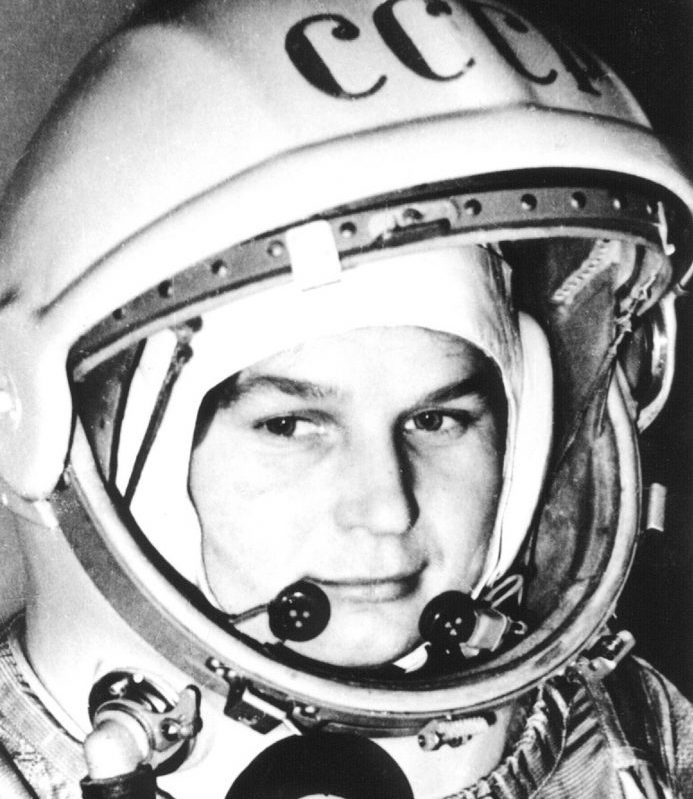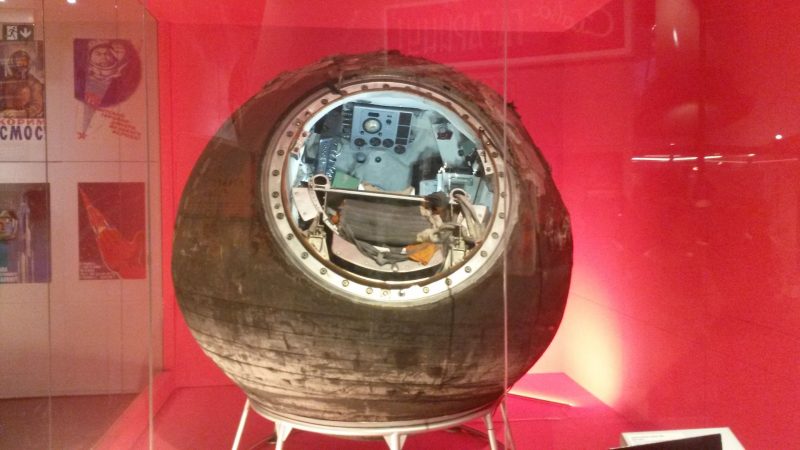

Valentina Tereshkova in her spacesuit. Image via ESA.
On June 16, 1963, 26-year-old Valentina Tereshkova, under the radio call name Chaika (Seagull), was launched solo aboard the Soviet rocket Vostok 6, becoming the first-ever woman in space. She spent nearly 71 hours total in space, orbiting the Earth 48 times.
As part of her mission, Tereshkova performed tests to collect data on how her body responded to being in a weightless environment, and maintained a detailed flight log. This was later compared to how her male cosmonaut colleagues were affected. She also took photographs of Earth from orbit, which were used to identify aerosol layers in the atmosphere.
Tereshkova’s mission lasted an impressive two days, 23 hours, and 12 minutes. That’s longer than all the U.S. Mercury mission astronauts who had flown up to that date combined.
Tereshkova’s flight was heralded as a leap forward for women, although next female cosmonaut, Svetlana Savitskaya, did not fly until 1982. The United States’ first female astronaut, Sally Ride, rocketed into space 20 years after Tereshkova, on June 18, 1983.

Valentina Tereshkova. Image via RIA Novosti/ Wikipedia.
Valentina Tereshkova was born on March 6, 1937, in the village of Bolshoye Maslennikovo, near Yaroslavl, Russia. She became interested in skydiving as a teenager, and made her first jump in May 1959 at the age of 22. Her mother worked in a textile factory and her father was a tractor driver. When she was first selected to be a cosmonaut, she was also working in textile factory.
Tereshkova was one of five women chosen out of more than 400 applicants. The others were Tatyana Kuznetsova, Irina Solovyova, Zhanna Yorkina and Valentina Ponomaryova. All of them trained for several months, which included weightless flights, isolation tests, centrifuge tests, 120 parachute jumps and pilot training in jet aircraft.
Originally, Tereshkova had been scheduled to launch on a Vostok 5 rocket, followed by Ponomaryova on the Vostok 6. But that plan was changed in March 1963. A male cosmonaut, Valeri Bykovsky, flew in Vostok 5 at the same time as Tereshkova in Vostok 6, on June 16, 1963.
Her flight was celebrated, with her image broadcast all over the Soviet Union, and she spoke to Premier Nikita Khrushchev by radio. Novopromyshna Square in Tver, near Moscow, was renamed Tereshkova Square in 1963 in her honor.
Tereshkova did not return to space again, but she did become a colonel in the Soviet Air Force by 1976, and in April 1977, she earned a doctorate in aeronautical engineering. She also continued as an instructor at the Yuri Gagarin Cosmonaut Training Center. She retired from the Soviet Air Force in 1997, after achieving the rank of major general. In 2007, Tereshkova was invited to Prime Minister Vladimir Putin’s residence in Novo-Ogaryovo for the celebration of her 70th birthday. She mentioned that she would like to fly to Mars one day, even if it meant that it was a one-way trip. She said:
If I had money, I would enjoy flying to Mars. This was the dream of the first cosmonauts. I wish I could realize it! I am ready to fly without coming back.

The Vostok 6 capsule in which Tereshkova orbited the Earth in 1963. Image via Science Museum/ Wikipedia.
But while she was still enthusiastic about space travel for cosmonauts, Tereshkova did say in 2013, on the 50th anniversary of her space flight, that she disapproved of space tourists. She has also been concerned about the risk of an asteroid collision with Earth, as she told The Guardian in 2017:
People shouldn’t waste money on wars, but come together to discuss how to defend the world from threats like asteroids coming from outer space.
The historic flight of Tereshkova to space in 1963 not only solidified her legacy as the first woman to go into orbit, but also paved the way for future women cosmonauts and astronauts to follow in the years afterward.
Bottom line: Valentina Tereshkova, a Soviet cosmonaut, was the first-ever woman to go to space, in 1963.
from EarthSky https://ift.tt/3hx9qjo


Valentina Tereshkova in her spacesuit. Image via ESA.
On June 16, 1963, 26-year-old Valentina Tereshkova, under the radio call name Chaika (Seagull), was launched solo aboard the Soviet rocket Vostok 6, becoming the first-ever woman in space. She spent nearly 71 hours total in space, orbiting the Earth 48 times.
As part of her mission, Tereshkova performed tests to collect data on how her body responded to being in a weightless environment, and maintained a detailed flight log. This was later compared to how her male cosmonaut colleagues were affected. She also took photographs of Earth from orbit, which were used to identify aerosol layers in the atmosphere.
Tereshkova’s mission lasted an impressive two days, 23 hours, and 12 minutes. That’s longer than all the U.S. Mercury mission astronauts who had flown up to that date combined.
Tereshkova’s flight was heralded as a leap forward for women, although next female cosmonaut, Svetlana Savitskaya, did not fly until 1982. The United States’ first female astronaut, Sally Ride, rocketed into space 20 years after Tereshkova, on June 18, 1983.

Valentina Tereshkova. Image via RIA Novosti/ Wikipedia.
Valentina Tereshkova was born on March 6, 1937, in the village of Bolshoye Maslennikovo, near Yaroslavl, Russia. She became interested in skydiving as a teenager, and made her first jump in May 1959 at the age of 22. Her mother worked in a textile factory and her father was a tractor driver. When she was first selected to be a cosmonaut, she was also working in textile factory.
Tereshkova was one of five women chosen out of more than 400 applicants. The others were Tatyana Kuznetsova, Irina Solovyova, Zhanna Yorkina and Valentina Ponomaryova. All of them trained for several months, which included weightless flights, isolation tests, centrifuge tests, 120 parachute jumps and pilot training in jet aircraft.
Originally, Tereshkova had been scheduled to launch on a Vostok 5 rocket, followed by Ponomaryova on the Vostok 6. But that plan was changed in March 1963. A male cosmonaut, Valeri Bykovsky, flew in Vostok 5 at the same time as Tereshkova in Vostok 6, on June 16, 1963.
Her flight was celebrated, with her image broadcast all over the Soviet Union, and she spoke to Premier Nikita Khrushchev by radio. Novopromyshna Square in Tver, near Moscow, was renamed Tereshkova Square in 1963 in her honor.
Tereshkova did not return to space again, but she did become a colonel in the Soviet Air Force by 1976, and in April 1977, she earned a doctorate in aeronautical engineering. She also continued as an instructor at the Yuri Gagarin Cosmonaut Training Center. She retired from the Soviet Air Force in 1997, after achieving the rank of major general. In 2007, Tereshkova was invited to Prime Minister Vladimir Putin’s residence in Novo-Ogaryovo for the celebration of her 70th birthday. She mentioned that she would like to fly to Mars one day, even if it meant that it was a one-way trip. She said:
If I had money, I would enjoy flying to Mars. This was the dream of the first cosmonauts. I wish I could realize it! I am ready to fly without coming back.

The Vostok 6 capsule in which Tereshkova orbited the Earth in 1963. Image via Science Museum/ Wikipedia.
But while she was still enthusiastic about space travel for cosmonauts, Tereshkova did say in 2013, on the 50th anniversary of her space flight, that she disapproved of space tourists. She has also been concerned about the risk of an asteroid collision with Earth, as she told The Guardian in 2017:
People shouldn’t waste money on wars, but come together to discuss how to defend the world from threats like asteroids coming from outer space.
The historic flight of Tereshkova to space in 1963 not only solidified her legacy as the first woman to go into orbit, but also paved the way for future women cosmonauts and astronauts to follow in the years afterward.
Bottom line: Valentina Tereshkova, a Soviet cosmonaut, was the first-ever woman to go to space, in 1963.
from EarthSky https://ift.tt/3hx9qjo

Aucun commentaire:
Enregistrer un commentaire